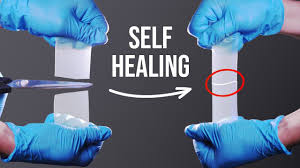
Self-Repairing Materials: The Future of Durability
The concept of self-repairing materials has captured the imagination of scientists and engineers for decades. Inspired by biological systems that heal themselves, self-repairing materials are engineered to restore their functionality after damage, significantly extending their lifespan and reducing maintenance costs. These materials have the potential to revolutionize industries ranging from construction to electronics, paving the way for a more sustainable and resilient future.
What Are Self-Repairing Materials?
Self-repairing materials are designed to detect and repair damage without external intervention. These materials can restore their mechanical, thermal, or electrical properties after being compromised, mimicking the natural healing processes seen in living organisms.
Mechanisms of Self-Repair
- Intrinsic Self-Repair:
- Intrinsic materials have built-in mechanisms, such as reversible bonds or shape-memory polymers, that enable them to repair themselves without external inputs.
- Extrinsic Self-Repair:
- Extrinsic systems rely on embedded microcapsules, vascular networks, or nanoparticles filled with repair agents that activate upon damage.
- Thermal Activation:
- Some materials require heat to trigger the self-repair process, enabling bonds to reform or material flow to fill cracks.
- Chemical Activation:
- Specific chemical reactions, such as polymerization or crystallization, are used to repair structural damage.
Applications of Self-Repairing Materials
- Construction:
- Self-healing concrete can repair cracks by using embedded microcapsules containing healing agents, improving infrastructure durability.
- Aerospace:
- Lightweight self-repairing composites are being developed to enhance the safety and longevity of aircraft components.
- Electronics:
- Flexible self-repairing materials ensure the durability of wearable devices and electronic circuits, reducing e-waste.
- Automotive:
- Self-healing coatings can repair scratches on vehicle surfaces, maintaining aesthetic appeal and protecting underlying materials.
- Healthcare:
- Self-healing hydrogels are used in wound dressings and tissue engineering, supporting faster recovery and reducing the need for replacements.
Advantages of Self-Repairing Materials
- Cost Efficiency:
- Reduced maintenance and repair costs make these materials economically appealing for large-scale applications.
- Sustainability:
- Prolonging the lifespan of materials reduces waste and the environmental impact of manufacturing.
- Enhanced Safety:
- Self-repairing materials can prevent catastrophic failures by addressing damage before it becomes critical.
- Innovation Potential:
- New designs and functionalities become possible with materials that can adapt and heal themselves.
Challenges in Developing Self-Repairing Materials
- Material Complexity:
- Engineering materials with self-repair capabilities without compromising their primary properties is a significant challenge.
- Cost:
- High production costs limit the commercial viability of these materials.
- Scalability:
- Scaling up the production of self-repairing materials for industrial use is a work in progress.
- Reliability:
- Ensuring consistent performance over multiple repair cycles remains a technical hurdle.
Future Directions
- Advanced Composites:
- Research is focusing on integrating self-repair capabilities into high-performance composites for aerospace and automotive applications.
- Smart Materials:
- Combining self-repairing properties with other smart functionalities, such as sensing and responsiveness, for multifunctional use.
- Eco-Friendly Materials:
- Developing self-repairing materials using sustainable resources to align with global environmental goals.
- Automation and AI:
- Leveraging artificial intelligence to monitor damage and trigger repair processes in real-time.
Conclusion
Self-repairing materials represent a significant advancement in material science, offering solutions to longstanding challenges in durability, cost, and sustainability. As research continues to address current limitations, these materials are poised to play a transformative role in building a more resilient and efficient world. Whether in infrastructure, technology, or healthcare, the potential of self-repairing materials to reduce waste, enhance safety, and drive innovation is undeniable.
